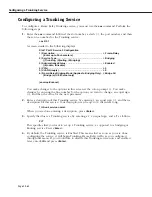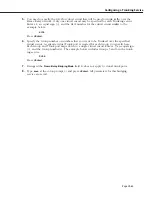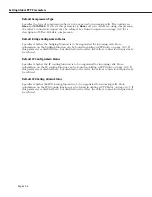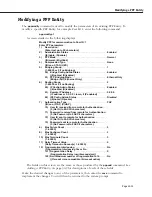
Page 30-1
30
Point-to-Point Protocol
The Point-to-Point Protocol (PPP) provides a standard method for transporting multi-protocol
datagrams over point-to-point links. The base protocol is specified in RFC 1661. Many other
RFCs define additional capabilities for network protocol negotiation, management information
databases (MIBs), and PPP operation over different kinds of serial channels.
PPP is comprised of three main components. The first component is a method of
encapsulating multi-protocol datagrams so that the underlying protocol can be identified; the
second component is the Link Control Protocol (LCP) that is used for establishing,
configuring, and testing the datalink connection; the third component is a family of Network
Control Protocols (NCPs) that are used for establishing and configuring different network-
layer protocols such as IP and IPX.
The implementation of PPP for the Omni Switch/Router WAN Switching Modules supports
bridging, IP routing and IPX routing. Data compression of the PPP packets is also supported
when the WSX module contains a STAC 9705 Data Compression Coprocessor.
PPP Connection Phases
There are five phases to a PPP connection: Dead, Establish, Authenticate, Network, and
Terminate:
Dead.
The first phase is called the “Dead” phase because the physical channel has not yet
been activated.
Establish.
After the physical channel has been activated, the PPP connection enters the second
phase, called “Establish,” wherein it attempts to negotiate link-level parameters and options
using the Link Control Protocol (LCP). This phase ends when the LCP enters its own “open”
state.
Authenticate.
After LCP has reached its “open” state, the PPP connection enters the phase
called “Authenticate” wherein it tries to identify the peer with which it is attempting to
establish a connection. If the authentication option is enabled, either the Password
Authentication Protocol (PAP) or the Challenge Handshake Authentication Protocol (CHAP) is
used to perform the authentication. If authentication is not enabled, the PPP connection
proceeds to the next phase, “Network.”
Network.
After the “Authenticate” phase is successful (or when it is not enabled), the PPP
connection proceeds to the next phase, called “Network,” wherein the network protocols are
negotiated using the appropriate Network Control Protocol (NCP). For example, to negotiate
the use of IP over the PPP connection, the Internet Protocol Control Protocol (IPCP) is used.
The details of the negotiation are specific to each network protocol, but may include such
tasks as assigning network layer addresses. A network layer protocol must be negotiated
successfully before the exchange of protocol packets can proceed; but, once negotiated, the
protocol can begin to freely exchange packets. The PPP connection spends most of its time in
the “Network” phase, because this is where the active transmission of data occurs.
Terminate
. The final phase of a PPP connection is called the “Terminate” phase. This phase
begins when authentication is unsuccessful or the channel becomes inoperative. Very often,
this phase is simply bypassed, and PPP will return to the idle (Dead) phase when a channel is
disconnected.
Summary of Contents for Omni Switch/Router
Page 1: ...Part No 060166 10 Rev C March 2005 Omni Switch Router User Manual Release 4 5 www alcatel com ...
Page 4: ...page iv ...
Page 110: ...WAN Modules Page 3 40 ...
Page 156: ...UI Table Filtering Using Search and Filter Commands Page 4 46 ...
Page 164: ...Using ZMODEM Page 5 8 ...
Page 186: ...Displaying and Setting the Swap State Page 6 22 ...
Page 202: ...Creating a New File System Page 7 16 ...
Page 270: ...Displaying Secure Access Entries in the MPM Log Page 10 14 ...
Page 430: ...OmniChannel Page 15 16 ...
Page 496: ...Configuring Source Route to Transparent Bridging Page 17 48 ...
Page 542: ...Dissimilar LAN Switching Capabilities Page 18 46 ...
Page 646: ...Application Example DHCP Policies Page 20 30 ...
Page 660: ...GMAP Page 21 14 ...
Page 710: ...Viewing the Virtual Interface of Multicast VLANs Page 23 16 ...
Page 722: ...Application Example 5 Page 24 12 ...
Page 788: ...Viewing UDP Relay Statistics Page 26 24 ...
Page 872: ...The WAN Port Software Menu Page 28 46 ...
Page 960: ...Deleting a PPP Entity Page 30 22 ...
Page 978: ...Displaying Link Status Page 31 18 ...
Page 988: ...Displaying ISDN Configuration Entry Status Page 32 10 ...
Page 1024: ...Backup Services Commands Page 34 14 ...
Page 1062: ...Diagnostic Test Cable Schematics Page 36 24 ...
Page 1072: ...Configuring a Switch with an MPX Page A 10 ...
Page 1086: ...Page B 14 ...
Page 1100: ...Page I 14 Index ...
















































